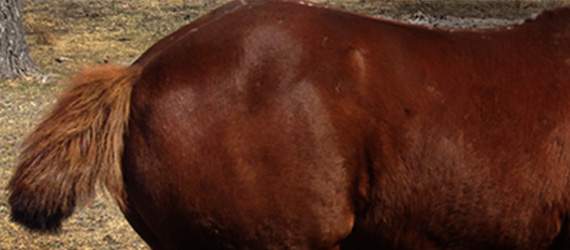I’ve been thinking about horses and abandonment recently. By abandonment, I mean a situation where a treasured or most favored horse has suffered an irreparable injury and has suddenly been dropped by the humans who previously lavished attention upon it. It happens quite a bit.
Do the horses know they’ve been abandoned? Yes, I believe so.
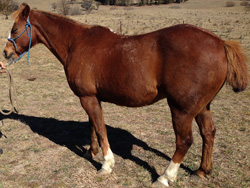 Take this pony, who currently goes by the name of Bob. His conformation speaks of Quarter Horse crossed with Welsh, with the Quarter Horse mainly walking behind the Welsh. Paddock condition doesn’t help on the looks front, as he’s obviously a ‘fat on fresh air’ type. But I’m putting that to one side, as it’s Bob himself that I’m interested in.
Take this pony, who currently goes by the name of Bob. His conformation speaks of Quarter Horse crossed with Welsh, with the Quarter Horse mainly walking behind the Welsh. Paddock condition doesn’t help on the looks front, as he’s obviously a ‘fat on fresh air’ type. But I’m putting that to one side, as it’s Bob himself that I’m interested in.
A power-packed pocket rocket, he’s one of those lovely straightforward guys that makes you smile almost as soon as you meet him. He gives every appearance of having been a true sports pony and, whatever his sport was (barrel racing?), he did it fast. The lad finds it hard to stand still in the paddock – he is wired to move.
And yet, with a damaged knee that tells of an unpleasant accident, he subsequently found himself at the sales.
At some point during this process, his tail was cut off. I somehow doubt that the person responsible did it to make memento jewelry. We have to assume that the hair was sold, as the owner at that time knew the pony was advancing on a one-way trip to the meat man (or to ‘the doggers’, to use Australia’s typically direct term).
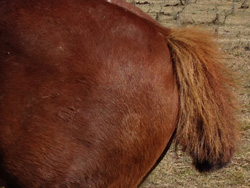
In economic terms, this action could be called ‘asset stripping’ – ie, getting every last cent possible by breaking a possession down and selling the parts. There’s obviously no regard for preservation of the whole or what’s left at the end.
Now, I do realize that once a horse is slaughtered, its remains are subject to asset stripping. Indeed, there’s a company near here that collects tendons for use in research. I also realize that by the time a horse hits the slaughter house floor, its tail will be somewhat less than clean, for a variety of reasons. There are obvious practicalities involved. But what I’m concerned about here is what’s happening to a living horse. So, let’s return to Bob…
Clearly, he hit a remarkable upswing when he was bought from the sales by a good man with plenty of land. Thankfully, the new owner wasn’t concerned about lack of ridability due to the knee injury, and was happy just to watch Bob being a pony in the paddock. If the pony demonstrated that he could carry a toddler along on the lead rein, then that would be great. But if he couldn’t, that was fine too. He wouldn’t be required to earn his keep – he could just be Bob.
At this point, I was asked to come out and give the pony some bodywork, just to see whether it would help make him more comfortable.

Now, during a bodywork session, it’s always apparent to me when a horse has lost its trust in people. I don’t mean a horse with so-called behavioral issues, although there are plenty of those, but a horse that knows its people have given up on it.
Such horses maintain a distance – not necessarily detaching themselves from what is happening, as they can be very physically cooperative. But they don’t come forward in an emotional sense. There’s a reserve that is incongruous to everything else that is going on.
It’s like being with a partner whose mind is partly on the football. Their presence is missing by, ooh let’s say 5-25%, depending on how much they support that team. No way can you not be aware of it! (I’m trying desperately to think of the female partner equivalent and failing at the moment.)
I spent an hour working with this pony and yet he still maintained his not-quite-there reserve. That was the choice that felt best to him at the time, and that was OK with me. So I left, expecting that to be that.
Driving away, I thought more about that crudely chopped tail. The tail that somebody’s hands had once carefully groomed had, ultimately, been roughly removed. I had to wonder whether it was by the same or another pair of hands.
The next day, earlier than expected, I received a phone call from Bob’s owner.
“I went to the paddock today,” he said, “and that pony walked straight up to me for the first time, looking for a fuss. He’s not done that before.”
Now, this is the kind of thing I like to hear. It might sound a small thing, but as the owner recognized, the small thing was significant precisely because it had been absent before. Something important had changed for Bob during the intervening hours.
He felt physically better and had decided that it was OK to trust a person again.
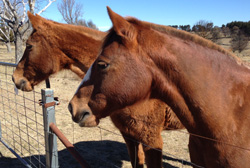
I am so pleased that this outcome transpired for this particular pony. And I am grateful for meeting horses like this, for it’s their beautiful forgiving souls that prevent my anger from rising.
For the truth is that I quietly despise owners who will use such a willing horse or pony up, and then dump their injured animal at the sales, in full knowledge that it is only ever going to be slaughtered at the end of a few stress-inducing weeks or days. Very few share Bob’s luck at this stage.
I am certainly not misguided into thinking that there is a home for every broken and injured horse, or even that all horses can find a home, injured or not. Those who make it to companion or paddock ornament status are incredibly fortunate. And I recognize that not all horses are treated as I treat mine. People own horses for different reasons.
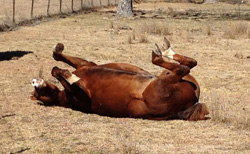 But I have to ask, what price a dignified end? It seems that the attraction of a couple of hundred bucks, symbolized by Bob’s severed tail, is simply too much for their owners to turn away.
But I have to ask, what price a dignified end? It seems that the attraction of a couple of hundred bucks, symbolized by Bob’s severed tail, is simply too much for their owners to turn away.
